Kdenlive/Manual/QuickStart/zh-tw: Difference between revisions
Updating to match new version of source page |
Updating to match new version of source page |
||
| Line 13: | Line 13: | ||
<br style="clear: both;"/> | <br style="clear: both;"/> | ||
[[File:Kdenlive Quickstart-New-Project.png|thumb|left| | [[File:Kdenlive Quickstart-New-Project.png|thumb|left|250px|New Project dialog]] | ||
Open '''Kdenlive''' and create a new project (<menuchoice>File</menuchoice> → <menuchoice>New</menuchoice>). | |||
選擇剛才新建的目錄夾(<tt>quickstart-tutorial/</tt>) ,然後選擇一個合適的專案描述檔。上面提供的影片是720p, 23.98 fps.<ref>[http://en.wikipedia.org/wiki/720p 720] 是片的高度 , p 代表 [http://en.wikipedia.org/wiki/Progressive_scan 增進式掃描] 可對照 [http://en.wikipedia.org/wiki/Interlaced_video interlaced video], 而 fps 數字表示每秒鐘的影格數.</ref> 假如您用自己的檔案並不清楚該用那一個, '''Kdenlive''' 在你載入第一個素材時將建議你一個合適的描述檔<ref> Kdenlive 設定提供的組態, 在 [[Special:myLanguage/Kdenlive/Manual/Settings_Menu/Configure_Kdenlive#Misc|Misc ]] 這裏設定成 ''Check if first added clip matches project profile當第一個素材加入時檢查合適的專案描述檔''</ref> | 選擇剛才新建的目錄夾(<tt>quickstart-tutorial/</tt>) ,然後選擇一個合適的專案描述檔。上面提供的影片是720p, 23.98 fps.<ref>[http://en.wikipedia.org/wiki/720p 720] 是片的高度 , p 代表 [http://en.wikipedia.org/wiki/Progressive_scan 增進式掃描] 可對照 [http://en.wikipedia.org/wiki/Interlaced_video interlaced video], 而 fps 數字表示每秒鐘的影格數.</ref> 假如您用自己的檔案並不清楚該用那一個, '''Kdenlive''' 在你載入第一個素材時將建議你一個合適的描述檔<ref> Kdenlive 設定提供的組態, 在 [[Special:myLanguage/Kdenlive/Manual/Settings_Menu/Configure_Kdenlive#Misc|Misc ]] 這裏設定成 ''Check if first added clip matches project profile當第一個素材加入時檢查合適的專案描述檔''</ref> | ||
| Line 81: | Line 81: | ||
==== 特效 ==== | ==== 特效 ==== | ||
[[File:Kdenlive Quickstart-Add-Effect.png|thumb|left | [[File:Kdenlive Quickstart-Add-Effect.png|thumb|left|Effect List]] | ||
The Piano can be colourized by adding an ''effect'' to it. Select the piano clip, then double-click the <menuchoice>RGB Adjustment</menuchoice> effect in the <menuchoice>Effect List</menuchoice>. If it is not visible, you can get it via <menuchoice>View</menuchoice> → <menuchoice>Effect List</menuchoice>. | |||
<br style="clear: both;"/> | <br style="clear: both;"/> | ||
| Line 91: | Line 91: | ||
<br style="clear: both;"/> | <br style="clear: both;"/> | ||
[[File:Kdenlive-Quickstart-EffectStack.png|thumb|left| | [[File:Kdenlive-Quickstart-EffectStack.png|thumb|left|402px|Effect Stack with RGB adjustment]] | ||
To get a warm yellow-orange tone on the image, fitting the comfortable evening, blue needs to be reduced and red and green improved. | |||
The values in the Properties widget can be changed by using the slider (middle mouse button resets it to the default value), or by entering a value directly by double-clicking the number to the right of the slider. | The values in the Properties widget can be changed by using the slider (middle mouse button resets it to the default value), or by entering a value directly by double-clicking the number to the right of the slider. | ||
| Line 102: | Line 102: | ||
<br style="clear: both;"/> | <br style="clear: both;"/> | ||
[[File:Kdenlive Quickstart-Keyframes.png|thumb|left| | [[File:Kdenlive Quickstart-Keyframes.png|thumb|left|401px|Keyframes for effects]] | ||
After clicking the <menuchoice>keyframe</menuchoice> icon (the clock icon framed in the previous image), the Properties widget will re-arrange. By default there will be two keyframes, one at the beginning of the timeline clip and one at the end. Move the timeline cursor to the end of the timeline clip, such that the project monitor actually shows the new colours when changing the parameters of the keyframe at the end. | |||
Make sure the last keyframe is selected in the Properties list. Then you are ready to flood the piano with a deep blue. | |||
將播放紅線移至專案的開頭,然後播放 (使用 <keycap>Space</keycap>, 或是 <menuchoice>專案監視器</menuchoice>)下方的<menuchoice>播放</menuchoice>鍵, piano 應該會如願的變色. | 將播放紅線移至專案的開頭,然後播放 (使用 <keycap>Space</keycap>, 或是 <menuchoice>專案監視器</menuchoice>)下方的<menuchoice>播放</menuchoice>鍵, piano 應該會如願的變色. | ||
| Line 120: | Line 120: | ||
Since the clips do not provide any audio, let’s search for some nice piece of music, from your local collection or on web pages like [http://www.jamendo.com Jamendo]. The audio clip should, after adding it, be dragged to an audio track on the timeline. | Since the clips do not provide any audio, let’s search for some nice piece of music, from your local collection or on web pages like [http://www.jamendo.com Jamendo]. The audio clip should, after adding it, be dragged to an audio track on the timeline. | ||
The audio clip can be resized on the timeline the same way as video clips are. The cursor will snap in at the end of the project automatically. To add a fade out effect at the end of the audio clip (except if you found a file with exactly the right length) you can hover the top right (or left) edge of the timeline clip and drag the red shaded triangle to the position where fading out should start.<ref>This shaded triangle is a shorthand for adding the effect <menuchoice>Fade</menuchoice> → <menuchoice>Fade out</menuchoice>. Both ways lead to the same result.</ref> | |||
<br style="clear: both;"/> | <br style="clear: both;"/> | ||
Revision as of 07:50, 16 April 2019
Quick Start
創建新專案
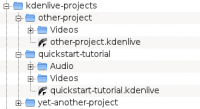
首先,創建新(空)的目錄夾給我們專案使用. 我將稱它 quickstart-tutorial/ 在本次的教學之中.然後放上一些範例素材, 或從這裏下載:kdenlive-tutorial-videos-2011-avi.tar.bz2 (7 MB)[1], 然後將它們解壓縮。 例如. 放到本專案下的子目錄 quickstart-tutorial/Videos/ .
左邊的圖片顯示建議的目錄結構:每個專案有自己的目錄,將影片檔放在Videos 子目錄,聲音檔放在 Audio子目錄,等。(read more)
(從現在開始,本教學假設您使用範例影片,當然你也可以用其他的範例影片。)
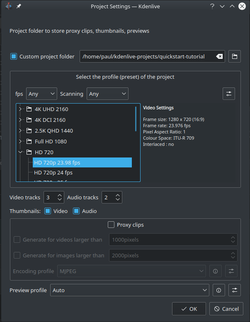
Open Kdenlive and create a new project ( → ).
選擇剛才新建的目錄夾(quickstart-tutorial/) ,然後選擇一個合適的專案描述檔。上面提供的影片是720p, 23.98 fps.[2] 假如您用自己的檔案並不清楚該用那一個, Kdenlive 在你載入第一個素材時將建議你一個合適的描述檔[3]
加上素材
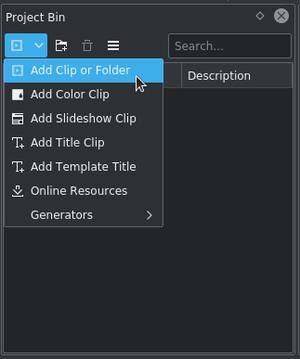
Now that the project is ready, let’s start adding some clips (i.e. the ones you downloaded). This works via the Project Bin widget; a click on the icon ![]() directly opens the file dialog, a click on the small arrow shows a list of additional clip types that can be added as well. Video clips, audio clips, images, and other Kdenlive projects can be added via the default dialog.
directly opens the file dialog, a click on the small arrow shows a list of additional clip types that can be added as well. Video clips, audio clips, images, and other Kdenlive projects can be added via the default dialog.
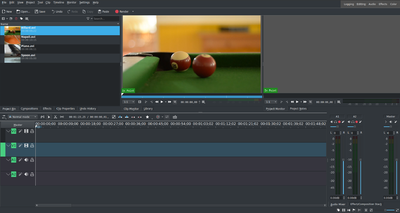
After loading the clips, Kdenlive will look similar to this. On the top left there is the already known project tree. Right of it are the monitors that show video; The clip monitor displays video from the original clips, the project monitor shows how the output video will look, with all effects, transitions, etc. applied. The third, also very important, item is the timeline (below the monitors): This is the place where the video clips will be edited. There are two different types of tracks, Video and Audio. Video tracks can contain any kind of clip, audio tracks as well – but when dropping a video file to the audio track, only the audio will be used.
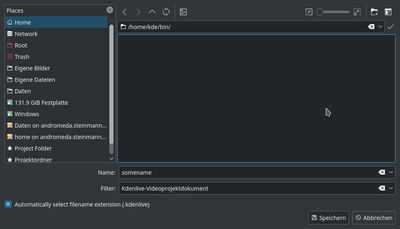
讓我們透過 存檔. 整個專案會儲存, i.e. 當我們在時間軸上放上影片, 用上了特效, 等等異動. 目前還 不能 播放.[4] 產生最終影片的過程稱為 Rendering.
時間軸
可參閱 使用手冊的時間軸章節
Now comes the actual editing. Project clips are combined to the final result on the timeline. They get there by drag and drop: Drag some Napoli (assuming you are using the files provided above, as in the rest of this quick start tutorial; If not, please make sure your screen is waterproof, and perhaps tomatoproof) from the project tree, and drop it onto the first track in the timeline.
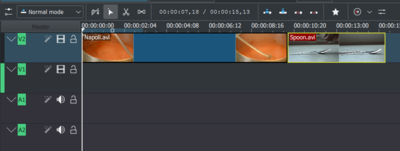
Since some cutlery is needed as well, grab the spoon clip and drop it on the first track as well. Then drag the Napoli to the beginning of the timeline (otherwise the rendered video would start with some seconds of plain black), and the Spoon right after the Napoli, such that it looks like in the image on the left. (Where I have zoomed in with Ctrl + Wheel.)

預覽結果,可按 Space (或 專案監視器的 ). 你將看到 Napoli 之後接著 Spoon. 假如時間軸的播放線( cursor )不在開頭處, 專案覽視器會在某處開始播放; 你可在時間軸的度量尺上拖曳播放線或是或是在專案監視上按倒帶鍵. 假如你偏愛快速鍵, Ctrl + Home 可以對播放的監視器做一樣的事. (選擇 如果你要用快速鍵時,還沒選擇的話.)

Since after eating comes playing, there is a Billiards clip. Add it to the timeline as well. For the first 1.5 seconds nothing happens in the clip, so it should perhaps be cut to avoid the video becoming boring. An easy way[5] for this is to move the timeline cursor to the desired position (i.e. the position where you want to cut the video), then drag the left border of the clip when the resize marker appears. It will snap in at the timeline cursor when you move close enough.
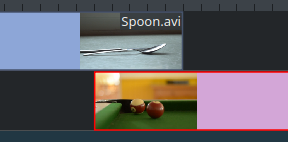
To add a transition between eating (the Spoon) and playing billiards, the two clips need to overlap. To be precise: the second clip should be above or below the first one and end some frames after the second one begins. Zooming in until the ticks for single frames appear helps here; it also makes it easy to always have the same transition duration, five frames in this case.
您可經由 Kdenlive 視窗下方的, 或是 Ctrl + Mousewheel來放大. Kdenlive 將對時間播放紅線來放大縮小, 所以首先你可將你想要放大的部分設定其位置, 然後放大它.
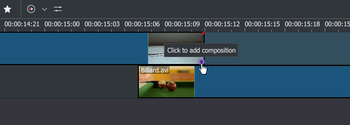
Now that the clips overlap, the transition can be added. This is done either by right-clicking on the upper clip and choosing or, easier, by hovering the mouse over the lower right corner of the Spoon clip until the pointing-finger pointer is shown and the message "Click to add transition" appears. The latter, by default, adds a dissolve transition, which is in this case the best idea anyway since the Spoon is not required for playing.
dissolve 轉場將第一素材慢慢淡出後接到第二素材. 可參閱 使用手冊的轉場章節.

加上最後的素材, Piano, 同樣再加上 dissolve 轉場. 當您把它加入時間軸的第一軌時, 您必須點擊新素材的左下邊將轉場加到前一段素材.
特效
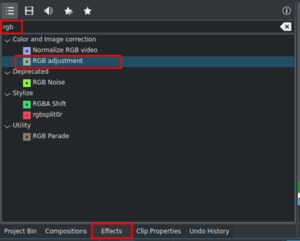
The Piano can be colourized by adding an effect to it. Select the piano clip, then double-click the effect in the . If it is not visible, you can get it via → .
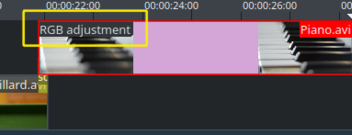
Once the effect has been added, its name will be added to the timeline clip. It will also be shown in the widget.
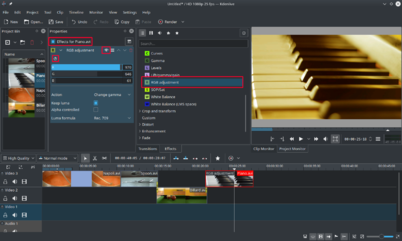
To get a warm yellow-orange tone on the image, fitting the comfortable evening, blue needs to be reduced and red and green improved.
The values in the Properties widget can be changed by using the slider (middle mouse button resets it to the default value), or by entering a value directly by double-clicking the number to the right of the slider.
The Properties widget always refers to the timeline clip that is currently selected. Each effect can be temporarily disabled by clicking the eye icon, or all effects for that clip can be disabled using the check box at the top of the Properties widget (the settings are saved though), this is e.g. useful for effects that require a lot of computing power, so they can be disabled when editing and enabled again for rendering.
有些特效,像這裏用到的,可以新增關鍵影格。The framed watch icon indicates this.關鍵影格用於隨時間改變特效參數. 在我們的素材可以讓我們讓 piano的淡色從溫暖的黃昏色調慢慢淡出成冷冷的夜晚色調.
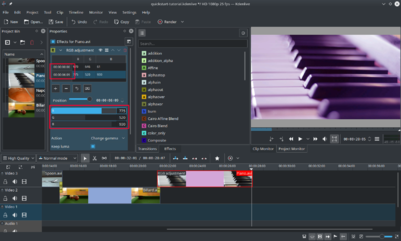
After clicking the icon (the clock icon framed in the previous image), the Properties widget will re-arrange. By default there will be two keyframes, one at the beginning of the timeline clip and one at the end. Move the timeline cursor to the end of the timeline clip, such that the project monitor actually shows the new colours when changing the parameters of the keyframe at the end.
Make sure the last keyframe is selected in the Properties list. Then you are ready to flood the piano with a deep blue.
將播放紅線移至專案的開頭,然後播放 (使用 Space, 或是 )下方的鍵, piano 應該會如願的變色.
關鍵影格是本教學裏最困難的部分. 假如你可以正確完成它, 之後您將輕易地經通Kdenlive !
可參閱Effects section of the manual。
音樂

Since the clips do not provide any audio, let’s search for some nice piece of music, from your local collection or on web pages like Jamendo. The audio clip should, after adding it, be dragged to an audio track on the timeline.
The audio clip can be resized on the timeline the same way as video clips are. The cursor will snap in at the end of the project automatically. To add a fade out effect at the end of the audio clip (except if you found a file with exactly the right length) you can hover the top right (or left) edge of the timeline clip and drag the red shaded triangle to the position where fading out should start.[6]
合成
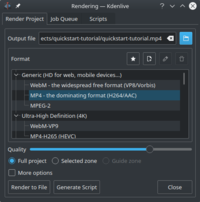
花了幾分鐘時間, 您已完成了專案! 請按下Render 按鍵 (或是 , 或是 Ctrl + Enter) 打開位於左邊的對話盒. 選擇想要我們的新影片(含特效及轉檔)的輸出格式, 選 MPEG4 (幾乎是到處皆可用) 選 2000k 的bitrate(bitrate愈高, 輸出檔容量愈大 ,品質愈好 – 不過,因為原來的素材已經是 2000k bitrate , 使用較高的bitrate並不會改善品質,因此沒必要), 然後按下 按鍵.
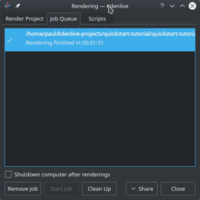
幾秒後,將完成合成(rendering) , 你的第一個 Kdenlive 專案完成. 恭禧!
Complete manual
Further documentation for the current version of Kdenlive can be found in the full manual.
參考與注意事項
- ↑ 假如你偏好 Theora (因為你覺得 Ogg 格式的影片常發生問題), 你可以從這裏下載 kdenlive-tutorial-videos-2011-ogv.tar.bz2.
- ↑ 720 是片的高度 , p 代表 增進式掃描 可對照 interlaced video, 而 fps 數字表示每秒鐘的影格數.
- ↑ Kdenlive 設定提供的組態, 在 Misc 這裏設定成 Check if first added clip matches project profile當第一個素材加入時檢查合適的專案描述檔
- ↑ 想要播的話, 可以 用指令
melt yourproject.kdenlive來播放, 但這不是您想要播放最終影片的方式因為 這樣太慢 (大部分時候) . 此外, 它要有安裝melt 才能播放. - ↑ Writing it this way suggests that there are several ways of cutting a clip. This is in fact true.
- ↑ This shaded triangle is a shorthand for adding the effect → . Both ways lead to the same result.
